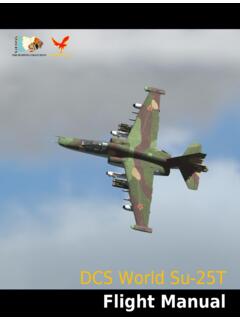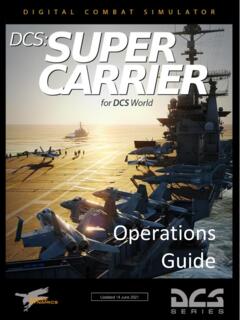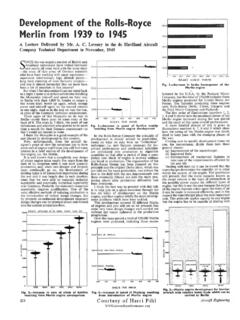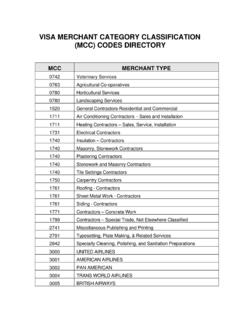Transcription of Early Access Manual
1 Early Access Manual DCS [DH 98 Mosquito FB Mk. VI] 2 Dear User, Thank you for purchasing the DCS: de Havilland DH 98 FB Mk. VI Mosquito! The DCS: FB Mk. VI Mosquito is a thrilling simulation of the fastest, most powerful and most effective British fighter-bomber of the Second World War. True to the DCS tradition of excellence, the DCS: Mosquito FB Mk. VI brings you a real sense of what it is like to fly and fight this iconic aircraft. Its devastating firepower, which includes four 20mm Hispano-Suiza cannons, four machine guns, and a range of bombs and rocket projectiles make it effective in pinpoint strike; anti-shipping; ground-attack, CAS and night-fighter missions. As a pure air supremacy fighter, the Mk. VI Mosquito s speed, rates of climb and dive and overall handling meant it could hold its own against the enemy s best opposing fighters, including the Fw 190D-9 and the Bf 109K. As members of The Fighter Collection, one of the largest collections of WWII remanufactured aircraft, and of the Eagle Dynamics development team, we have used our expert knowledge of WWII aviation to ensure that this simulation is one of the most accurate replicas ever made of the Mosquito FB Mk.
2 VI. Documentation studies, hangar visits, and numerous consultations with TFC pilots have been invaluable in crafting this product. The content of this Manual is based primarily on the surviving documentation for the DH 98 Mosquito FB Best regards, DCS Development Team, FB [DH 98 Mosquito FB VI] DCS Eagle Dynamics 3 TABLE OF CONTENTS INTRODUCTION .. 5 AIRCRAFT HISTORY .. 7 AIRCRAFT CONSTRUCTION .. 17 Description .. 18 Fuselage .. 20 Canopy .. 21 Armor .. 21 Wing .. 22 Flight Control System .. 23 Landing Gear .. 25 Fuel System .. 29 Oil System .. 30 Cooling System .. 33 Hydraulic System .. 34 Pneumatic System .. 35 Electrical System .. 38 Oxygen Supply System .. 39 Weapon Systems .. 40 Rockets and Bombs .. 41 Radio Communications .. 42 Emergency Equipment .. 43 Reflector Gunsight .. 44 Camera and Gun Camera .. 45 COCKPIT .. 47 Front Instrument Panel .. 47 Flight Instruments .. 48 Electrical Services Switch .. 48 Magneto Switches .. 49 Engine Starter Buttons.
3 50 Airspeed indicator Mk. IX F .. 51 DCS [DH 98 Mosquito FB Mk. VI] 4 Cockpit left side .. 73 Cockpit Right Side .. 82 Pre-flight procedures .. 99 Landing Procedures .. 106 Limitations .. 108 Machine guns and cannons .. 115 Radio Communications Window .. 120 LIST OF TERMS AND ABBRIVATIONS .. 131 Airbase Data .. 141 Credits .. 143 [DH 98 Mosquito FB VI] DCS Eagle Dynamics 5 INTRODUCTION One of the most revolutionary and effective combat aircraft of WWII, the British de Havilland Mosquito was in service with the Royal Air Force (RAF) from 1940 to 1961. A brilliant and innovative design, the Mossie left a bright and lasting mark in the history of aviation. An airframe built mostly of wood to save on scarce metal supplies earned the Mosquito the nickname "The Wooden Wonder". It was also known as Freeman s Folly after the Air Marshal who backed its production. Armed with four (.303in) Browning machine guns and four 20mm (.79in) Hispano-Suiza cannons, this superbly versatile fighter-bomber could carry both bomb and rocket payloads over long distances at high speed and deliver them with pinpoint accuracy.
4 The Mossie s ability to maintain a high cruising speed at high altitude made it very difficult for Luftwaffe fighters in service at the time to attack it. The DCS: de Havilland Mosquito FB Mk VI fighter-bomber you will be flying is the most impressive variant of this aircraft to see action in total of 2,140 were produced. Equipped with more powerful Rolls- royce merlin 25 engines, the FB Mk. VI s excellent handling characteristics make it a real pleasure to fly. AIRCRAFT HISTORY AIRCRAFT HISTORY [DH 98 Mosquito FB VI] DCS Eagle Dynamics 7 AIRCRAFT HISTORY A Warbird with Movie Star Looks Some of the greatest warbirds ever built have had to fight to take wing. A dazzling concept for its time, the de Havilland Mosquito was one of these. Its designer, Geoffrey de Havilland s idea was simple: create a twin-engine medium bomber that was lighter and faster than any other aircraft in service, or that was likely be built before the war s end.
5 Build one, in fact, that was so fast that it would not only be able to outrun enemy fighters, it would not even need to carry defensive armament. A mainly wooden construction would help keep the Mossie s weight down, increase its speed and rate of climb, and save scarce and valuable metals for other use. Fresh thinking tends to frighten the conservative mind: some senior Air Ministry officials insisted that the new type had to be equipped with guns and turrets - and be made of metal, not wood. Brilliant original thinkers are few. Luckily for us, they do exist, and Geoffrey de Havilland was one of them. He was also persistent, resisting the doubters and keeping Early development of the Mosquito going with his own money. The prototypes proved him right: equipped with twin 1,460 horsepower Rolls royce merlin 21 engines, in February 1941 the Mosquito comfortably outran a Spitfire Mk II in level flight, reaching a top speed of 392 mph against the Spitfire s 360 mph.
6 A star was born. Air Marshal Wilfred Freeman knew a good thing when he saw it: on 21 June 1941, the Air Ministry authorized production of 19 Mosquito photo-reconnaissance (PR) models and 176 fighters. Orders for a fast medium bomber variant, the FB Mk. VI, quickly followed. Almost all production Mossies had four Hispano Mk II 20 mm cannon housed under the nose, with a further four Browning .303 inch machine guns ranged above those. Fitted with a bomb bay, the Mossie could also carry a 1,000 lb payload over a range of more than 1,500 miles. Underwing rails also enabled it to strike with a salvo of eight rockets. DCS [DH 98 Mosquito FB Mk. VI] 8 Figure 1: RAF Hunsdon, Hertfordshire: Armorers prepare to load four 500-lb MC bombs into the bomb-bay of De Havilland Mosquito FB Mk. VI, MM403 'SB-V', of No. 464 Squadron RAAF. [IWM CH Public Domain] [DH 98 Mosquito FB VI] DCS Eagle Dynamics 9 The World s First True Multi-Role Combat Aircraft A hit from the start, the Mosquito excelled in every role the war planners threw at it.
7 These kept on growing to meet the ever-changing demands of battle. Having proved its worth in photo-reconnaissance, the Mossie was next employed as a night-fighter. Using its integral Airborne Intercept AI and ground-based radar systems, it shot down an estimated 600 enemy aircraft in this role alone. As the aircraft s performance improved, with increasingly uprated merlin engines and tweaks to its construction, the Mossie was able to deliver a single, 4,000 lb Highball bomb on high-value targets. By 1944, it could also be fitted with racks to mount 60 lb RP rocket projectiles. Figure 2: Mosquito Mk. VI test firing its guns. Intruder As an intruder , the FB Mk. VI prowled occupied France and Nazi Germany, often at night, and with increasing frequency as D-Day approached. The aim was to cause maximum chaos and disruption to enemy lines of communication (trains were a target of choice), and to destroy other targets of opportunity.
8 A favorite tactic was to linger in the vicinity of Luftwaffe air bases; wait until enemy aircraft were in the process of landing; and shoot them down. DCS [DH 98 Mosquito FB Mk. VI] 10 Figure 3: Mosquito FB Mk. VI after a raid on V-1 launch site in Pas-de-Calais, 1944. Third Reich pilots loathed and feared the Mosquito FB Mk. VI in equal measure. Operation Jericho One of the best examples of Mossie s extraordinary capabilities was the operation to free Allied prisoners facing execution from Amiens prison. Figure 4: Mosquitos SB-U and SB-V of 464 Squadron crossing the Channel towards Amiens at wave top height. [Public Domain] [DH 98 Mosquito FB VI] DCS Eagle Dynamics 11 On the morning of 18th February 1944, nineteen Mosquito Mk VI fighter-bombers of No. 140 Wing, RAF 2nd Tactical Air Force, set out on one of the most daring raids of the Second World War. Attacking at very low level in three flights of six, 18 of the Mossies were to breach the outer and inner walls of Amiens prison in Northern France; bomb the canteen where the German guards were having their midday meal; and give the prisoners a chance to escape.
9 A final, photo-reconnaissance (PR) aircraft would film the entire mission, and, if it went well, broadcast the footage to help boost Allied morale. Figure 5: 487 Squadron Mosquitos over Amiens Prison as their bombs explode, showing the snow-covered buildings and landscape. [IWM Public Domain] DCS [DH 98 Mosquito FB Mk. VI] 12 Previous strikes on enemy factories, power stations, Gestapo headquarters and other high-value targets had already demonstrated the Mossie s astonishing ability to deliver high-explosive ordnance with pinpoint accuracy. But Operation Jericho was on a whole new level of difficulty. Before take-off, the pilots studied a detailed plaster-of-paris model of the prison s layout, along with maps of the surrounding area. A long, die-straight road ran south-west to Amiens from the town of Albert and bordered one side of the prison. It would serve as an excellent marker for the final approach. We heard the details of this mission with considerable four years of war just doing everything possible to destroy life, here we were going to use our skill to save it.
10 It was a grand feeling and every pilot left the briefing room prepared to fly into the walls rather than fail to breach them. There was nothing particularly unusual in it as an operational sortie, but because of this life-saving aspect it was to be one of the great moments in our lives. Wing Commander Irving Smith, No 487 Squadron RNZAF * Four stories in height, Amiens prison was built in the shape of a Latin cross, with the cells in the longer section and the guards canteen and quarters in the shorter arms. A 20-ft. brick perimeter wall surrounded the complex. The raid was a combined British Commonwealth enterprise. The first wave of six Mosquitos from 487 Squadron, Royal New Zealand Air Force (RNZAF), had the task of breaching the eastern and northern perimeter walls. The job of the next wave of six aircraft from 464 Sqn Royal Australian Air Force (RAAF), was to smash open either end of the cell block and destroy the German garrison. The final, RAF element would act as back-up if the initial attacks failed.









